All the bells and whistles with little fanfare.
FiiO is a proven contender in the headphone electronics market. They’ve enjoyed success with various products, including the rather great BTR5 portable DAC/amp released in 2020. This TOTL dongle set the standard for features and performance in a portable package.
The new BTR7 is the successor to the BTR5 and builds on the former’s do-it-all flexibility, bringing a revised design, higher capacity battery, updated Bluetooth chipset, and THX AAA amplification. Unfortunately, all these updates come at a price point nearing twice that of the BTR5.
With the BTR7 you get a high-power 4.4mm balanced headphone output, hi-res Bluetooth codec support, 32/386 file format decoding, and a color IPS display.
- Clean and transparent sound
- Lots of audio options to tweak the sound
- App features innovative features like parametric EQ, battery saver, and output boost
- High power 4.4mm balanced output
- The internal battery can be switched on and off as desired
- Great screen
- No included USB-c to Lightning cable in the Standard Edition
- Larger than a typical dongle DAC/amp
The question is whether paying for all these new bells and whistles is worth it.
Rather than beating around the bush, let’s just say that this little powerhouse deserved to make it onto our coveted 10 Best Portable DAC/Amps roundup and captured the title of ‘Most Flexible.’
Company Overview
Guangzhou FiiO Electronics Technology Co., Ltd. (FiiO for short) was established in 2007 in Guangzhou City, China. FiiO has developed many portable music products, including high-resolution digital audio players, portable headphone amplifiers, DACs, and earphones. FiiO adheres strictly to ISO9001 standards in quality management and, according to the website, works hard to attain the lowest repair-related product returns rate.
FiiO strives to bring innovation, quality, and great service to affordable audio products and positions itself as “HiFi with style.”
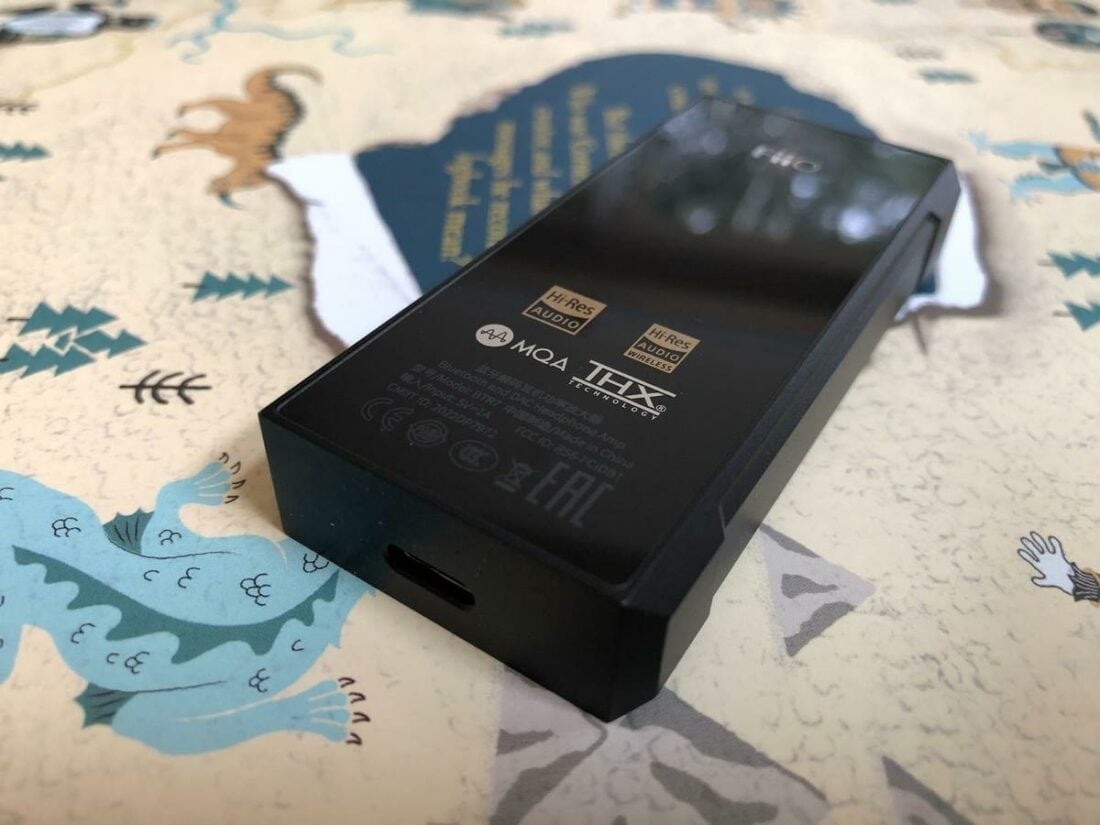
Technical Specifications
- Form: Portable DAC/Amp
- DAC Chipset: ESS Technology ESS9219C x2
- USB DAC Support: DSD256, PCM 384kHz, MQA 8x
- Amplifier: THX AA-28 x2
- Bluetooth Chipset: Qualcomm QCC5124
- Bluetooth Version: 5.1
- Bluetooth Codec Support: SBC, AAC, aptX Low Latency/HD/Adaptive, LDAC
- USB Controller: XMOS XUF208
- Microphone: Omnidirectional
- Analog Outputs: SE: 3.5mm, Balanced: 4.4mm
- Power Output: SE: 160mW, Balanced: 320mW
- Display: 1.3-inch IPS color
- Battery Capacity: 880 mAh, 7-9 hours
- Battery Charging: Qi wireless, USB-c
- Dimensions: 83.5 × 39.5 × 14.5mm
- Weight (g): 68g
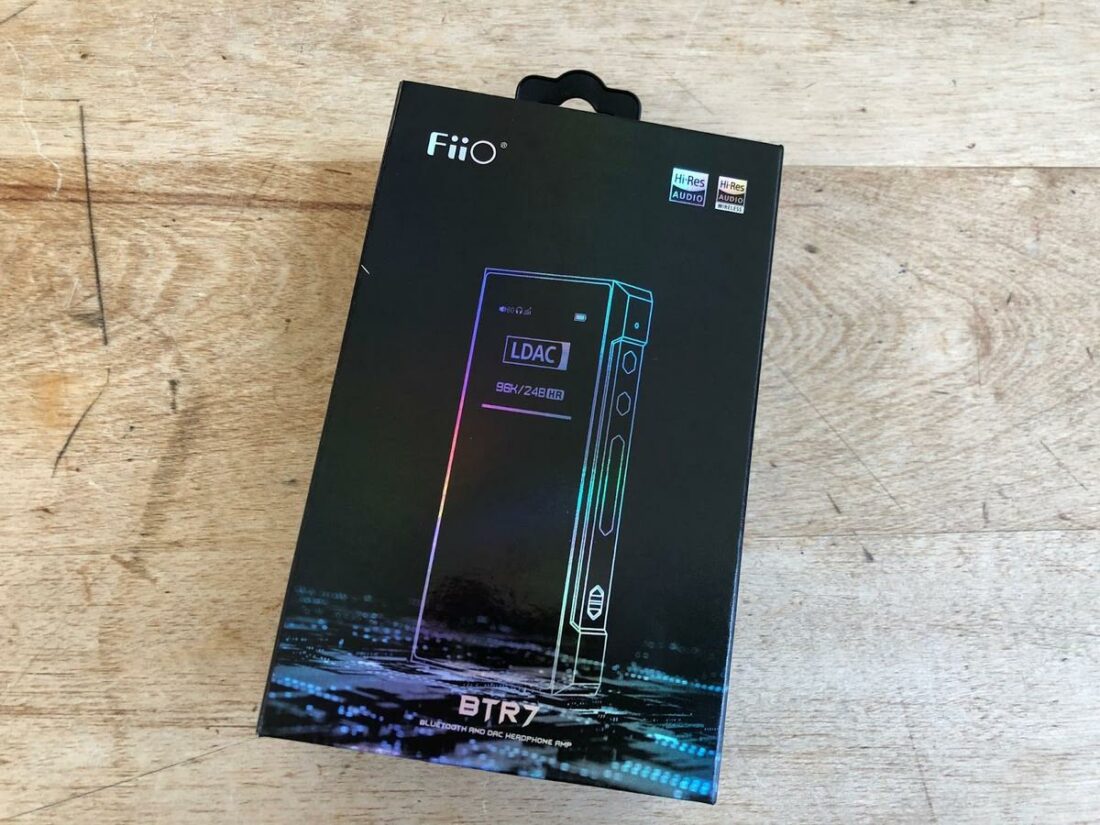
Packaging
As is typical of FiiO products, the BTR7 comes in an attractive black cardboard box with embossed images and writing. The device is cradled in foam, underneath which are the accessories.
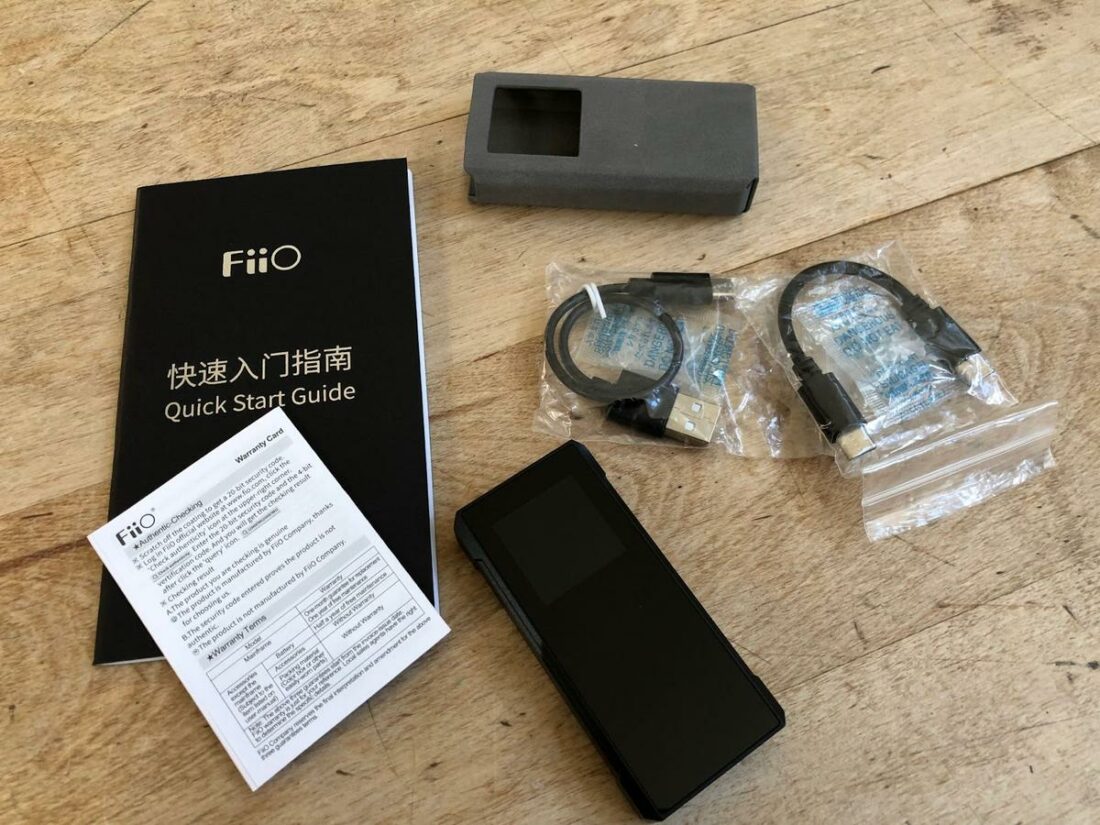
In the box
- Fiio BTR7
- USB-a to USB-c cable
- USB-c to USB-c cable
- Leatherette case
- User guide
- Warranty card
While the included accessory bundle is fairly sparse, it is sufficient for Android, Bluetooth, and computer users – only Apple devices are left wanting. The grey faux-suede case is an excellent addition as it protects the glossy glass surfaces of the BTR7 and allows access to the buttons, ports, and display.
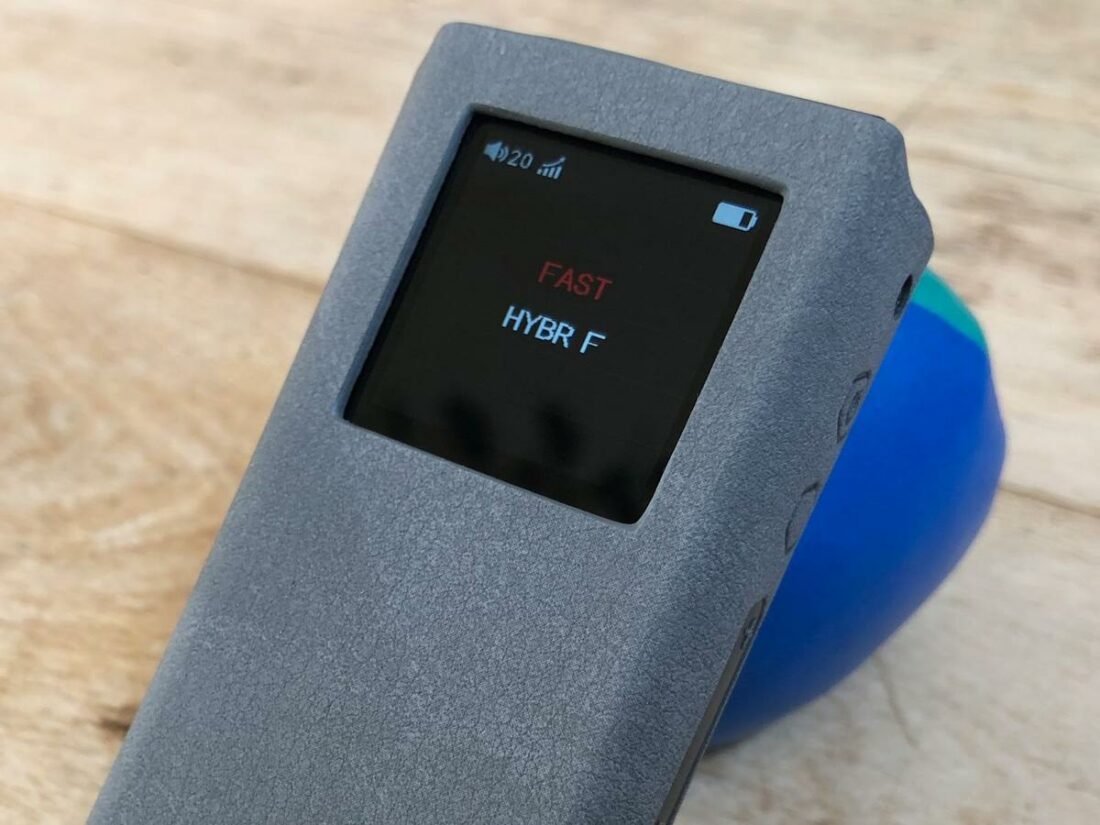
Design
The all-black design of the BTR7 is slightly larger and heavier than its predecessor, the BTR5 (68g vs. 44g). It’s somewhat large for a DAC/Amp dongle, but is nowhere near the size of the Chord Mojo or other portables and is far more pocketable. Both the front and back are glass, while the remaining surfaces are chamfered aluminum.
The obvious standout feature is the 1.3” IPS color display on the front upper surface, which shows handy information such as the file format, battery level, volume, options menu, signal strength, etc.
While not touch sensitive nor user configurable, the screen has a resolution of 240×240 pixels with a density of 260PPI. It is bright and clear regardless of lighting conditions.
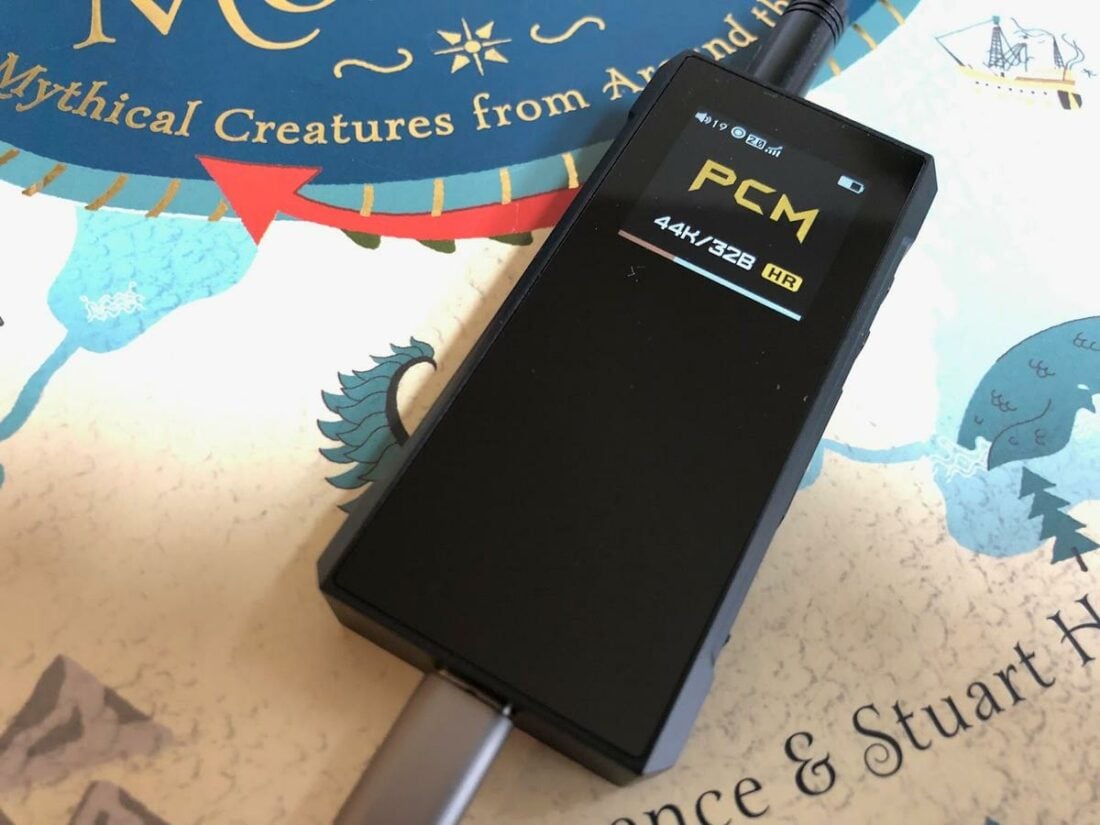
The top edge contains the 4.4mm balanced and 3.5mm single-ended headphone outputs. On the bottom is the single USB-c port. The right side contains all the controls: power, play, up/down buttons, charge switch, and microphone.
The simple control scheme is intuitive and doesn’t require extensive reading of the manual to get up and running. Power it on without connecting a USB cable, and the BTR7 immediately goes into Bluetooth pairing mode (if a previously paired device isn’t discovered). Press and hold the play button to manually activate Bluetooth pairing.
Press and hold the power button for 2 seconds to access the menu system. Press and hold for 5 seconds to power the BTR7 on or off. Use the up and down buttons to navigate and change the volume or track. Use the play button to select.
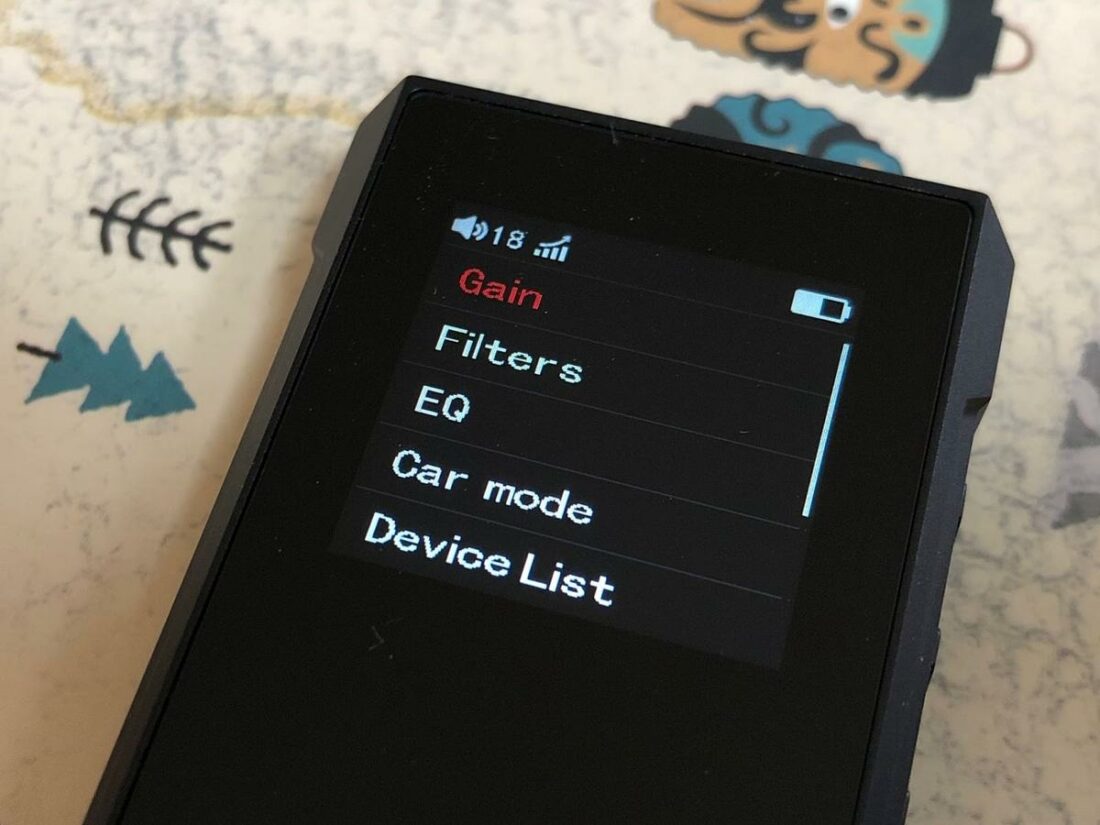
Options menu
- Gain (high or low)
- Filters (fast or hybrid)
- EQ (off, jazz, pop, rock, dance, user, r&b, classical, hip-hop – ‘user’ custom preset must be set in the app)
- Car Mode (on or off – powered on/off by USB port)
- U-audio (UAC 1.0 or UAC 2.0 USB modes – 1.0 allows connection without drivers)
- Dimmer (1-5)
- Language (English or Chinese)
- Screen timeout (5-30 seconds)
- Input priority (Bluetooth or UAC)
- Factory reset
- Version
Battery life is rated between 7-9 hours depending on Bluetooth codec, gain, volume, and headphone output used. Charging takes between 1-2 hours with a 2A charger.
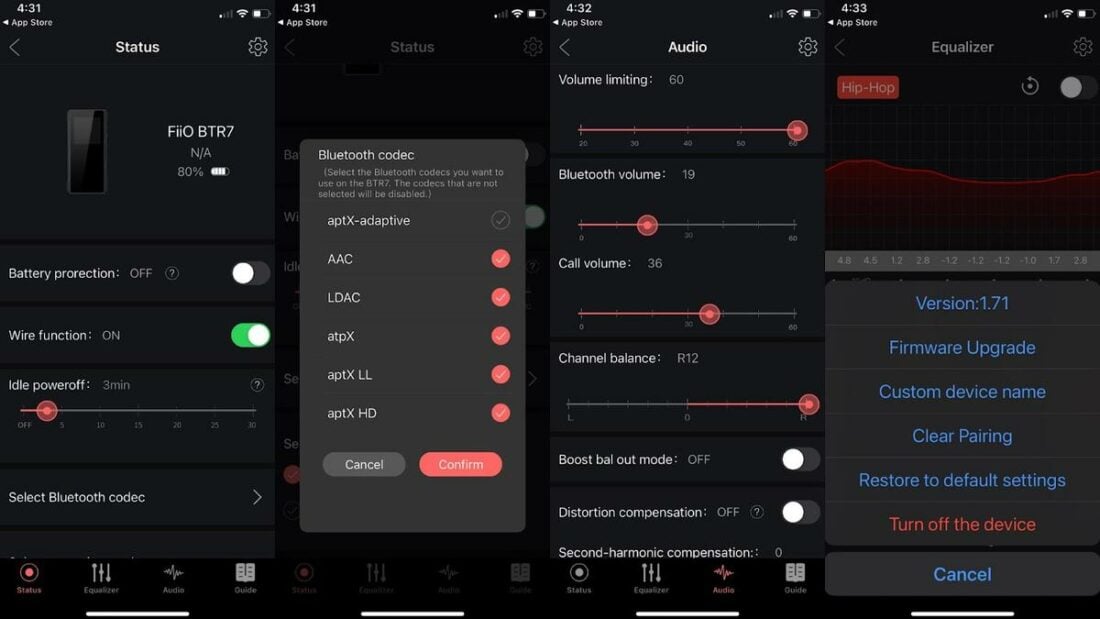
FiiO Control application
The FiiO application works quite well with the BTR7. The main benefit for users of the app is the parametric EQ, allowing fine sound adjustments. This is good news for the sound-tweakers out there.
The app enables a balanced output boost (‘Boost Bal out mode’) feature that further increases the power of the balanced output – beyond the high and low gain options in the menu. This may be useful with extremely difficult-to-drive, full-sized headphones, although the standard power output is sufficient for nearly all portable cans.
The other standout feature is the ‘battery protection’ mode, intended to improve the lifespan of the internal battery by limiting charging to 80%. The remaining settings in the app are pretty standard fare, and are all functional, if not exceptionally attractive or intuitive.
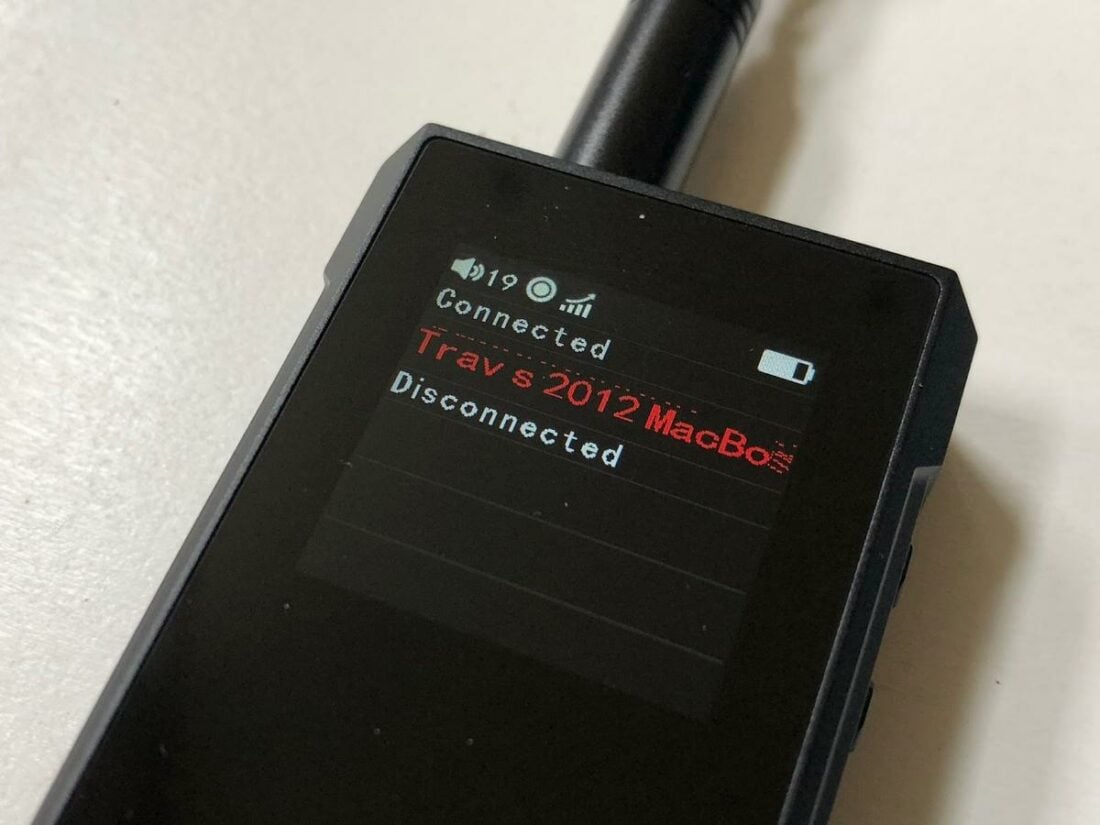
Internals
The BTR7 uses the same ESS Technology ESS9219C DAC chipset as the BTR5. However, the big change is the switch to a dual AAA28 THX amplifier. FiiO claims this provides 88% more single-ended power output and 30% more balanced power output than previous designs.
The DAC is capable of DSD256, PCM 32bit/384kHz, and MQA 8x decoding. Impressive specs for a small portable device.
I find the Bluetooth to work as expected, supporting two devices and with clean transmission nearly anywhere in my smallish-sized home.
The internal microphone works, but only if held near your mouth or used in a quiet environment. Let me disillusion you if you’ve dreamt of answering calls while the BTR7 resides in your jeans pocket.
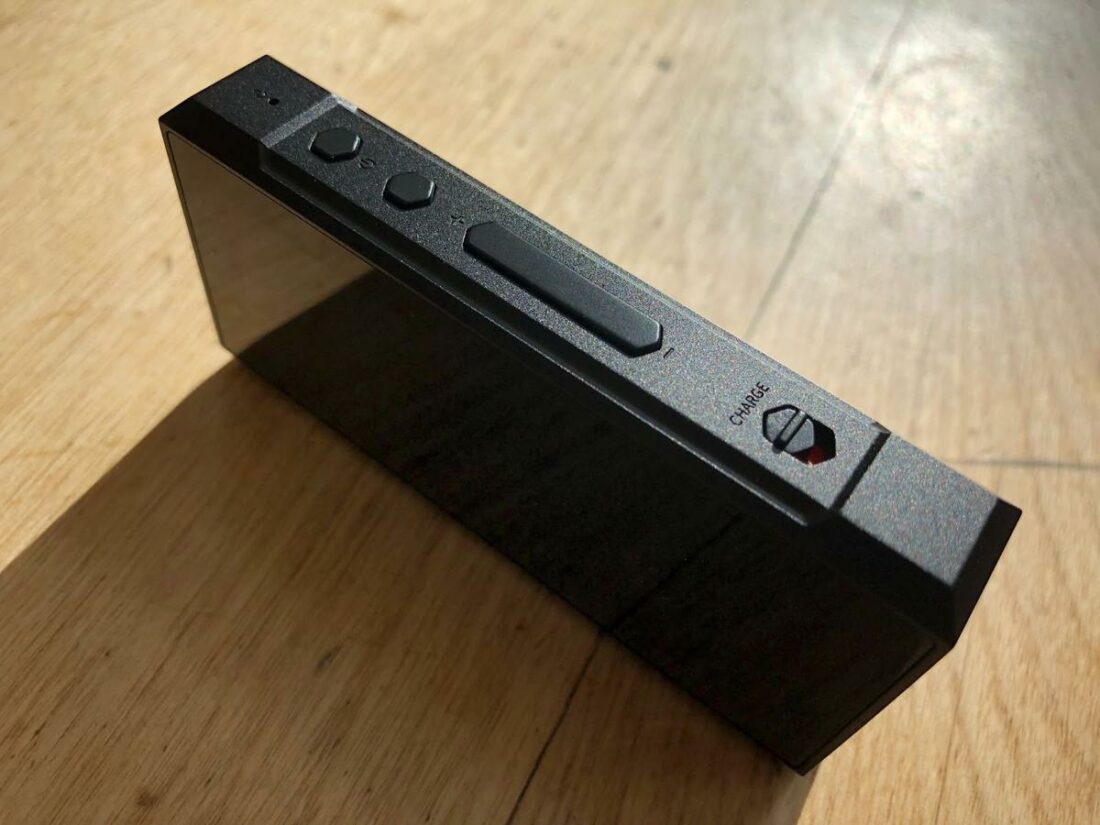
Output Power
With 160mW @32 Ohms SE and 320mW balanced power on hand, the BTR7 should drive any portable headphones you desire. Only the hard-to-drive outliers, such as full-sized planar magnetic headphones intended for home usage, struggle to get enough current to sound their best.
Officially, FiiO says the BTR7 will support headphones with impedances up to 150 Ohms, but more efficient, even higher-impedance models such as the Sivga SV023 and Sennheiser HD650 work fine.
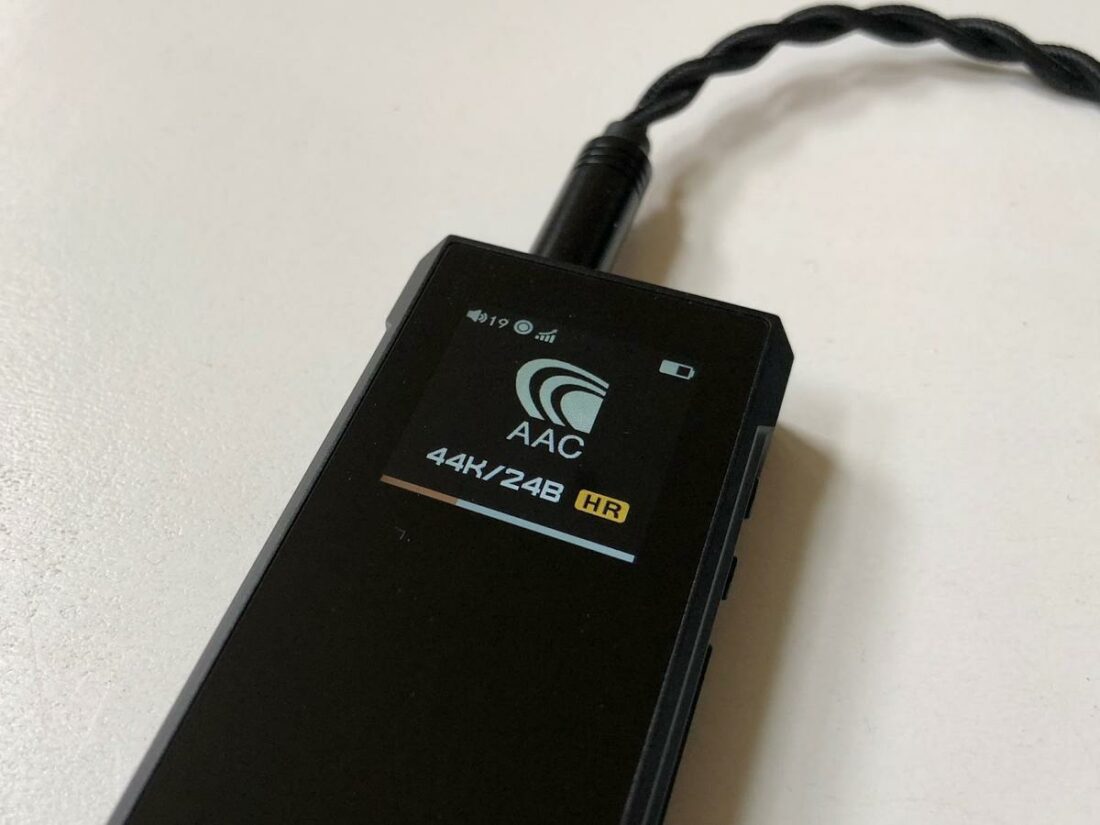
FiiO BTR7 Sound
I find the most significant audible differences between portable and dongle DAC/amps to arise with poor headphone pairings, with the meager power of the device expected to drive difficult loads, or occasionally with hybrid IEM impedance mismatches. The excellent news is that with the BTR7’s ample onboard power, these mismatches will be far more infrequent than with lesser devices.
The clean and powerful output makes the BTR7 easy to pair with most headphones and IEMs.
It’s all about flexibility with this sort of device, so one must test both the wired and wireless input modes. Bluetooth is inherently a mixed bag since devices such as iPhones only support the lesser AAC codec, while Android, PC, or DAPs will typically support higher-resolution wireless connections.
Bluetooth performance is generally as good as it gets with this type of connection. While most folks (myself included) are unlikely to use a wireless connection for critical listening, even AAC sounds absolutely acceptable on the BTR7. If you aren’t listening for it, you’ll likely forget you are connected wirelessly and just enjoy the lack of wires.
The USB mode connection works flawlessly, and while the difference between connection types is fairly subtle, the difference between headphone outputs is far less so.
The ability to swap between 3.5mm SE and 4.4mm balanced outputs, plus low and high gain settings, means you can dial in the power to match the headphones and IEMs you are using. I appreciate this flexibility, and toning down the output to ultra-sensitive IEMs improves the noise floor.
Using high gain and the balanced output, the BTR7 does a great job driving full-sized cans, maybe not quite to the level of a 1+Watt desktop setup, but quite respectable for a device of its small stature.
The music sounds full and rich, not lacking in dynamics or low-end grunt. These are good signs that the headphones are adequately powered, and the BTR7 does so with ease. If anything, there may be a slight tendency towards warmth and lower frequency response, but for the most part, the sound can be described as clear and uncolored.
THX amplification is known for being ultra-clean and is sometimes characterized as somewhat soulless as a result. I don’t get that impression with the BTR7, just that it amplifies the signal and gets out of the way, like an excellent solid-state amplifier should.
Plenty of effortless power on hand with no unwanted noise.
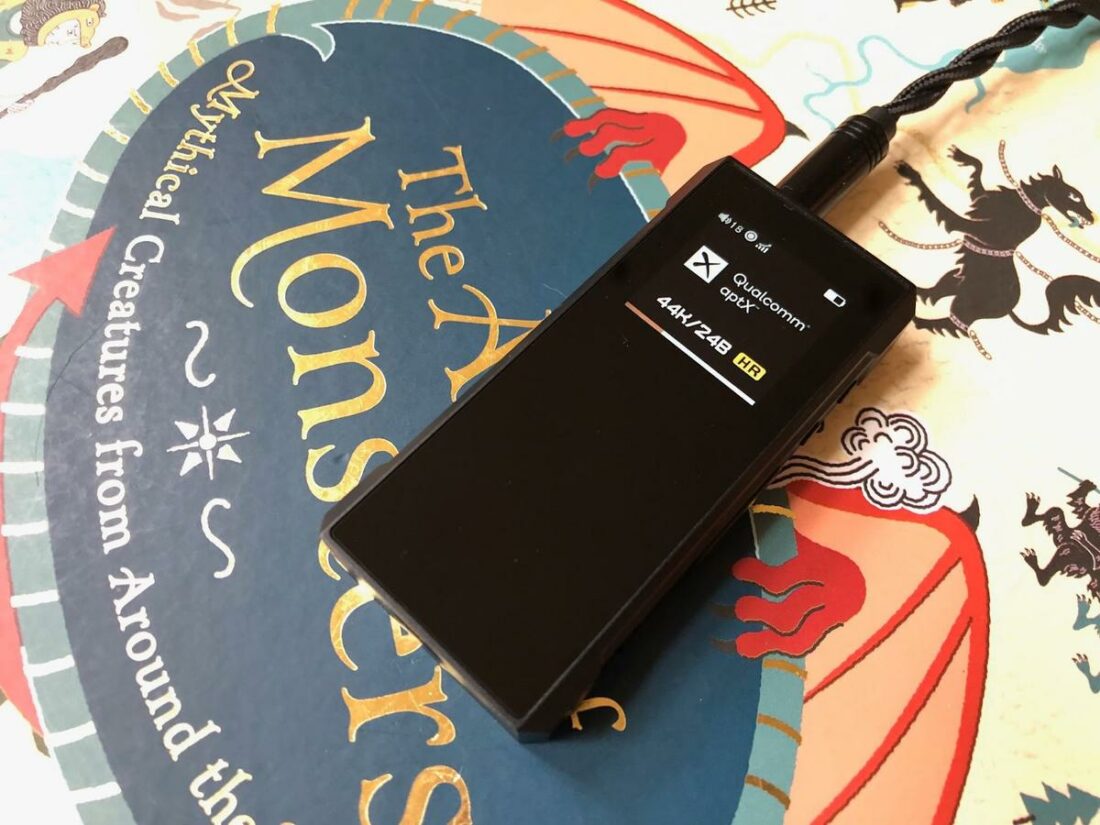
Where to Buy
Conclusion
The FiiO BTR7 is not a budget product aimed at the cost-conscious dongle buyer. It is not one of the dime-a-dozen, virtually indistinguishable, portable DAC/amp dongles currently on the market. It’s too large, powerful, flexible, and expensive to compete in that market.
The BTR7 is firmly aimed at the on-the-go audiophile who wants all the benefits of wireless portability without being limited by a single Bluetooth headset.
But what if my tastes change? I like IEMs this week, but I’ve had my eye on a pair of full-sized headphones. What if I want a device that works with my phone and computer? My collection of headphones aren’t all easy to drive.
The BTR7 is a buy-it-once device (albeit with a non-user replaceable internal battery) that is flexible enough to handle most possibilities with equal aplomb. It sounds great with nearly any pair of IEMs or headphones you plug into it. It can be tethered as a wired DAC/Amp to your computer. It can connect via Bluetooth to your phone.
Other devices may do one thing as well, or perhaps slightly better than the BTR7, but I’m hard-pressed to name another portable DAC/Amp that is so feature-rich yet no-nonsense. It does a myriad of tasks with ease, with the sort of no-muss, no-fuss audio prowess and design that I appreciate.

To be fair, you didn’t comment on the battery performance which is somewhat disappointing. I experienced no more than 4 hours operation/autonomy when using the LDAC bluetooth codec. It is a wonderful device held back only by its low capacity battery.
The BTR7 was a loaner unit, so I no longer have it, so it’s quite possible that battery life may change over longer term usage. My typical usage was AAC from my iPhone and not overly loud listening levels into efficient IEMs, so it’s tough to directly compare usage, but the battery lifespan you are experiencing seems significantly lower than what I ran into. It may be worth contacting customer support to see if they can address it. Thank you for sharing your experience!